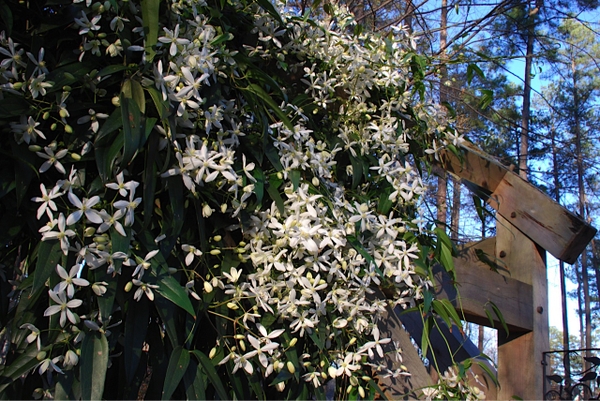Evergreen Clematis
go.ncsu.edu/readext?785673
en Español / em Português
El inglés es el idioma de control de esta página. En la medida en que haya algún conflicto entre la traducción al inglés y la traducción, el inglés prevalece.
Al hacer clic en el enlace de traducción se activa un servicio de traducción gratuito para convertir la página al español. Al igual que con cualquier traducción por Internet, la conversión no es sensible al contexto y puede que no traduzca el texto en su significado original. NC State Extension no garantiza la exactitud del texto traducido. Por favor, tenga en cuenta que algunas aplicaciones y/o servicios pueden no funcionar como se espera cuando se traducen.
Português
Inglês é o idioma de controle desta página. Na medida que haja algum conflito entre o texto original em Inglês e a tradução, o Inglês prevalece.
Ao clicar no link de tradução, um serviço gratuito de tradução será ativado para converter a página para o Português. Como em qualquer tradução pela internet, a conversão não é sensivel ao contexto e pode não ocorrer a tradução para o significado orginal. O serviço de Extensão da Carolina do Norte (NC State Extension) não garante a exatidão do texto traduzido. Por favor, observe que algumas funções ou serviços podem não funcionar como esperado após a tradução.
English
English is the controlling language of this page. To the extent there is any conflict between the English text and the translation, English controls.
Clicking on the translation link activates a free translation service to convert the page to Spanish. As with any Internet translation, the conversion is not context-sensitive and may not translate the text to its original meaning. NC State Extension does not guarantee the accuracy of the translated text. Please note that some applications and/or services may not function as expected when translated.
Collapse ▲Clem-a-tis or Cle-mat-is – how do you pronounce it?
Either way is fine and usually most gardeners know what group of plants you are talking about.

Climbing with support
Barbara Goodman
CC BY 2.0
I have an arbor that is covered with the Evergreen clematis, Clematis armandii. Another common name for this plant is Armand clematis. It is a wonderful, evergreen vine, that doesn’t seem to have any major insect or disease problems. Literature resources do list all parts of the plant as poisonous, causing severe burning sensation of pain and mouth ulcers if eaten.
Sensitive persons may have minor skin irritation. So, keep small children and pets who chew away.
The glossy, dark green foliage is an excellent backdrop for the pure white flowers on the vine that I have. The flowers begin to appear in March and sometimes persist into May and are wonderfully fragrant. There are cultivars such as Snowdrift, Apple Blossom available in the trade with pure white, white shaded pink, and pink flowers.
Evergreen clematis is a fast-growing vine that climbs via twisting stems and petioles and can quickly cover a trellis, fence, or arbor. This vine will grow in sun to part shade. It does prefer to have its roots protected from the sun and the top part of the vine in full sun.
The plant likes rich, loose, well-draining soil, high in organic matter with a pH of 6-7.5. It flowers on old wood and may require pruning after flowering to prevent the buildup of tangled dead stems in the center of the vine. Besides the wonderful traits of being evergreen and having deliciously fragrant flowers, the vine provides cover & food for birds and is resistant to deer damage.
Join the Extension Master Gardener℠ volunteers in Union County for the Successful Gardener program, Thursday, April 1, 2021, at 7 p.m. Michael Luther, Master Gardener℠ Volunteer, will discuss Container Gardening. The program will be held online via Zoom, so if you would like to receive the link to register, give me a call at 704-283-3729.




